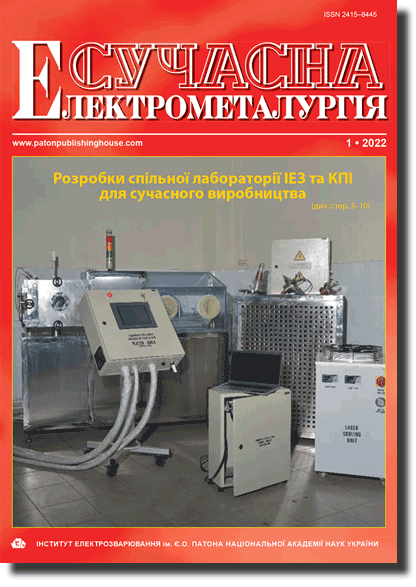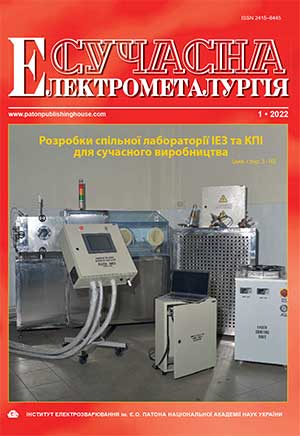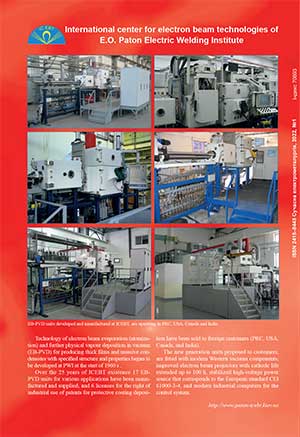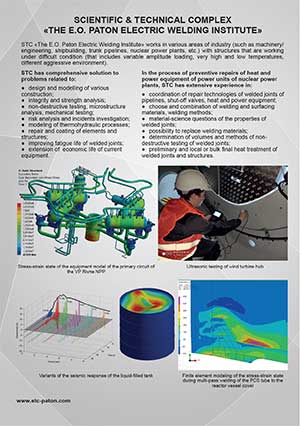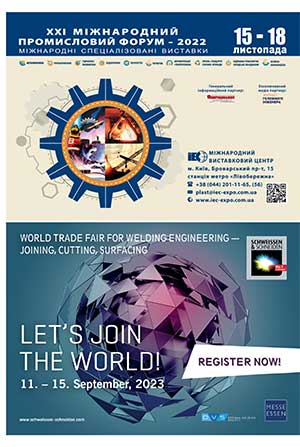| 2022 №01 (04) |
DOI of Article 10.37434/sem2022.01.05 |
2022 №01 (06) |
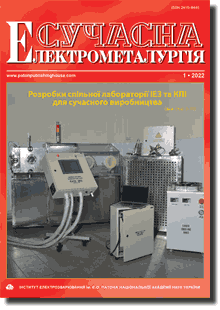
"Suchasna Elektrometallurgiya" (Electrometallurgy Today), 2022, #1, 40-46 pages
Technology for smelting zirconium alloy ingots by vacuum arc remelting with consumable electrode
O.Ye. Kapustian1, I.A. Ovchynnykova2, V.A. Zhdan2, Yu.M. Savonov1
1Zaporizhzhia Polytechnic National University. 64 Zhukovsky Str, 69063, Zaporizhzhia, Ukraine. E-mail: aek@zntu.edu.ua
2Zaporizhzhia National University. 66 Zhukovsky Str, 69063, Zaporizhzhia, Ukraine. E-mail: iaov31@gmail.com
Abstract
The results of studying the possibility of obtaining ingots from zirconium alloy of Zr‒Nb‒Ti system, using the method of vacuum arc remelting with a consumable electrode, are presented. Ingots of 50 mm diameter produced by remelting with a non-consumable electrode in a skull furnace were used as consumable electrodes. The technology of producing a zirconium alloy of a given composition by the method of vacuum-arc remelting of a consumable electrode into a copper mould has been developed. A complex of technological and material science problems was solved, a study of technological factors, metallurgical methods and processes, associated with selection of melting equipment and fixtures was carried out, a technological process was developed for obtaining ingots of a given homogeneous chemical composition for further deformation processing and producing an initial billet. An ingot of 120 mm diameter was melted in a vacuum arc furnace. The technological parameters of melting during arc remelting with a consumable electrode in a vacuum arc furnace were determined. A study of ingot metal of an experimental alloy of Zr‒Nb‒Ti system by the method of ultrasonic flaw detection showed absence of internal structural defects, namely discontinuities, shrinkage cavities, porosity or large non-metallic inclusions. Ref. 16, Table. 2, Fig. 3.
Keywords: vacuum arc remelting; furnace; electrode; arc; vacuum; zirconium alloy; ingot; technology; quality
Received 06.10.2021
References
1. Topolsky, V.F., Akhonin, S.V., Grigorenko, G.M., Petrichenko, I.K. (2012) Development of new titanium biocompatible alloys for medical applications. Advances in Elektrometallurgy, 1, 24-28.2. Levytskyi, M.I., Miroshnychenko, V.I., Anikin, Yu.P. et al. (2002) Titanium based casting alloy. Pat. 51032 Ukraine [in Ukrainian].
3. Gunter, V.E., Khodorenko, V.N., Yasenchuk, Yu.F. et al. (2006). Titanium nickelide. New generation medical material, MITs, Tomsk [in Russian].
4. Fisk, A., Demchyshin, A., Kuzmenko, M. et al. (2014) Titanium based ceramic reinforced alloy for use in medical implants. Pat. US2014105781 USA.
5. Grechanyuk, N.Y., Kulak, L.D., Smashnyuk, Yu.A. et al. (2017) Melting of titanium alloy ingots of the Ti-Nb-Si-Zr system by electron beam melting. Suchasna Elektrometal., 2, 17-20 [in Russian]. https://doi.org/10.15407/sem2017.02.03
6. Horna, I.D., Valuiska, K.O., Talash, V.M. et al. (2018) Influence of scandium on the properties of biocompatible titanium alloys Ti-23Nb-2Zr-X. In: Proc. of Conf. on Titanium 2018. Production and Application in Ukraine (Kyiv, Ukraine, 11-13 June, 2018), 40-43 [in Ukrainian].
7. Horna, I.D., Bulanova, M.V., Valuiska, K.O. et al. (2018) Influence of the low-modulus intermetallic phase Ti3Sn on the mechanical properties of eutectic alloys of the system Ti-Si- Sn. Ibid., 36-39 [in Ukrainian].
8. Kapustian, O.Ye., Ovchynnykov, О.V., Volchok, I.P. (2020) Investigate the possibility of using Zr-Ti-Nb alloys instead of titanium alloy Ti-6AL-4V for biomedical products. Visnyk KhNADU, 91(1), 15-22 [in Ukrainian]. https://doi.org/10.30977/BUL.2219-5548.2020.91.0.15
9. Mishchenko, O., Ovchynnykov, O., Kapustian, O., Pogorielov, M. (2020) New Zr-Ti-Nb alloy for medical application: Development, chemical and mechanical properties, and biocompatibility. Materials, 13(6), 1306. https://doi.org/10.3390/ma13061306
10. Ivasyshyn, O.M., Skyba, I.O., Karasevska, O.P., Markovskyi, P.Ye. (2013) Biocompatible alloy with low modulus of elasticity based on zirconium-titanium system (options). Pat. 102455 Ukraine [in Ukrainian].
11. Ovchynnykov, О.V., Kapustian, O.Ye. (2020) Technologies for smelting zirconium alloy ingots by vacuum arc remelting with a non-consumable electrode in a skull furnace. Suchasna Elektrometal., 4, 32-38 [in Ukrainian]. https://doi.org/10.37434/sem2020.04.06
12. Kapustian, O.Ye., Ovchynnykova, I.A. (2021) Production of deformed semi-finished products of zirconium alloy from ingots smelted by arc remelting method with a non-consumable electrode in a skull furnace. Ibid., 3, 28-34 [in Ukrainian]. https://doi.org/10.37434/sem2021.03.05
13. Gardy, A. (2013) Numerical simulation and experimental studies of remelting processes. Advances in Electrometallurgy, 4, 314-321.
14. Savenko, V.A., Kharitonova, E.A. (2016) Electron beam melting of zirconium-hafnium binary alloy of nuclear purity binary. Sovrem. Elektrometal., 4, 28-38 [in Russian]. https://doi.org/10.15407/sem2016.04.05
15. Potapov, V.I. (2005) Thermophysical processes in secondary refining remelting and their improvement by methods of mathematical modeling: Syn. of Thesis for Dr. of Tech. Sci. Degree. Chelyabinsk [in Russian].
16. Gurevich, S.M. (1990) Reference book on non-ferrous metal welding. 2nd ed. Kiev, Naukova Dumka [in Russian].
Advertising in this issue:
The cost of subscription/purchase order journals or individual articles
| Journal/Currency | Annual Set | 1 issue printed |
1 issue |
one article |
| TPWJ/USD | 384 $ | 32 $ | 26 $ | 13 $ |
| TPWJ/EUR | 348 € | 29 € | 24 € | 12 € |
| TPWJ/UAH | 7200 UAH | 600 UAH | 600 UAH | 280 UAH |
| AS/UAH | 1800 UAH | 300 UAH | 300 UAH | 150 UAH |
| AS/USD | 192 $ | 32 $ | 26 $ | 13 $ |
| AS/EUR | 180 € | 30 € | 25 € | 12 € |
| SEM/UAH | 1200 UAH | 300 UAH | 300 UAH | 150 UAH |
| SEM/USD | 128 $ | 32 $ | 26 $ | 13 $ |
| SEM/EUR | 120 € | 30 € | 25 € | 12 € |
| TDNK/UAH | 1200 UAH | 300 UAH | 300 UAH | 150 UAH |
| TDNK/USD | 128 $ | 32 $ | 26 $ | 13 $ |
| TDNK/EUR | 120 € | 30 € | 25 € | 15 € |
AS = «Automatic Welding» - 6 issues per year;
TPWJ = «PATON WELDING JOURNAL» - 12 issues per year;
SEM = «Electrometallurgy Today» - 4 issues per year;
TDNK = «Technical Diagnostics and Non-Destructive Testing» - 4 issues per year.





